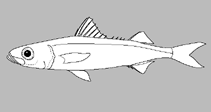Plagiogeneion unispina Parin, 1991
Upload your photos and videos
Google imageNo image available for this species;
drawing shows typical species in Emmelichthyidae.
Google imageNo image available for this species;
drawing shows typical species in Emmelichthyidae.
Classification / Names आम नाम | उपशब्द | Catalog of Fishes(वर्ग, प्रजाति) | ITIS | CoL | WoRMS | Cloffa
> Eupercaria/misc (Various families in series Eupercaria) > Emmelichthyidae (Rovers)
Etymology: Plagiogeneion: Greek, plagios = oblique + Greek, geny, genyos, diminutive = face (Ref. 45335); unispina: Named for its single sharp spine on the opercle.
Etymology: Plagiogeneion: Greek, plagios = oblique + Greek, geny, genyos, diminutive = face (Ref. 45335); unispina: Named for its single sharp spine on the opercle.
Environment: milieu / climate zone / depth range / distribution range पारिस्थितिकी
समुद्री बाथीड़िमरसल; गहराई सीमा 290 - 310 m (Ref. 28705). Deep-water
वितरण देश | ऐफ ऐ ओ क्षेत्र | Ecosystems | संयोग | Point map | भूमिका | Faunafri
Southeast Pacific: seamount on the western part of Sala y Gomez.
आकार / वज़न / Age
Life cycle and mating behavior परिपक्व अवधि | पुनरुत्पत्ति | मछलीऔ का अंडे देना | अंडे | Fecundity | लार्वा
Main reference
Upload your references | संदर्भ | संयोजक : Heemstra, Phillip C. | सहयोगीयो
Parin, N.V., 1991. Three new species of the benthopelagic fish genus Plagiogeneion from the southern Pacific and Indian oceans (Teleostei: Emmelichthyidae). Proc. Biol. Soc. Wash. 104(3):459-467. (Ref. 28705)
CITES
Not Evaluated
Threat to humans
Harmless
Human uses
FAO - Publication: search | FishSource |
अधिक जानकारी
Trophic ecology
खाद्य पदार्थ
संघटक आहार
आहार खपत
Food rations
परभक्षी
खाद्य पदार्थ
संघटक आहार
आहार खपत
Food rations
परभक्षी
Ecology
पारिस्थितिकी
पारिस्थितिकी
Population dynamics
Growth parameters
Max. ages / sizes
Length-weight rel.
Length-length rel.
Length-frequencies
Mass conversion
भर्ती
बहुतायत
Growth parameters
Max. ages / sizes
Length-weight rel.
Length-length rel.
Length-frequencies
Mass conversion
भर्ती
बहुतायत
Life cycle
पुनरुत्पत्ति
परिपक्व अवधि
Maturity/Gills rel.
Fecundity
मछलीऔ का अंडे देना
Spawning aggregations
अंडे
Egg development
लार्वा
लारवल गतिकी
पुनरुत्पत्ति
परिपक्व अवधि
Maturity/Gills rel.
Fecundity
मछलीऔ का अंडे देना
Spawning aggregations
अंडे
Egg development
लार्वा
लारवल गतिकी
Anatomy
गिल क्षेत्र
Brain
Otolith
गिल क्षेत्र
Brain
Otolith
Physiology
Body composition
Nutrients
Oxygen consumption
Swimming type
Swimming speed
Visual pigments
Fish sound
Diseases & Parasites
Toxicity (LC50s)
Body composition
Nutrients
Oxygen consumption
Swimming type
Swimming speed
Visual pigments
Fish sound
Diseases & Parasites
Toxicity (LC50s)
Genetics
आनुवंशिकी
Heterozygosity
हैरेटिबिलटी
आनुवंशिकी
Heterozygosity
हैरेटिबिलटी
साधन
E-book | कार्यक्षेत्र पथप्रदर्शक | लंबाई आवृति इंद्रजालिक | जीवन-इतिहास उपकरण | बिन्दु नक्शा | Classification Tree
| Catch-MSY |
Special reports
Download XML
Summary page | Point data | आम नाम | Photos
इंटरनेट स्रोत
AFORO (otoliths) | Aquatic Commons | BHL | Cloffa | BOLDSystems | Websites from users | Check FishWatcher | CISTI | Catalog of Fishes: वर्ग, प्रजाति | DiscoverLife | ECOTOX | FAO - Publication: search | Faunafri | Fishipedia | Fishtrace | GenBank: genome, nucleotide | GloBI | Google Books | Google Scholar | Google | IGFA World Record | MitoFish | Otolith Atlas of Taiwan Fishes | PubMed | Reef Life Survey | Socotra Atlas | Tree of Life | Wikipedia: Go, खोज | World Records Freshwater Fishing | Zoobank | Zoological Record
Estimates based on models
Phylogenetic diversity index (Ref. 82804): PD50 = 0.5313 [Uniqueness, from 0.5 = low to 2.0 = high].
Bayesian length-weight: a=0.01000 (0.00244 - 0.04107), b=3.04 (2.81 - 3.27), in cm total length, based on all LWR estimates for this body shape (Ref. 93245).
Trophic level (Ref. 69278): 3.4 ±0.4 se; based on size and trophs of closest relatives
लौटाव (Ref. 120179): माध्यम, न्यूनतम जनसंख्या दुगनी होने का समय 1.4 - 4.4 वर्ष। (Assuming tmax>3).
Fishing Vulnerability (Ref. 59153): Low vulnerability (19 of 100).




